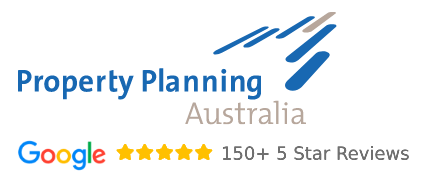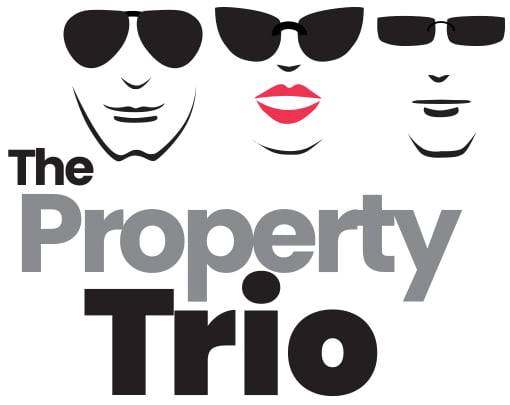Previously known as “The Property Planner, Buyer and Professor”
Got a question for the trio?
Submit our online form!Highlight segments:
Show notes:
Listener Question 1 – Hi Dave, Cate & Mike – love the show and have been burning through your podcast backlog after discovering it a couple of months ago. I’ve listened to about 100 episodes now and have learned some great tips, particularly from your case study series. My wife and I have quite a unique scenario and we’re weighing up our next purchase and would love your help. Perhaps our scenario could become a useful case study for other listeners to learn from also. Our PPOR home loan is fully offset but we plan to turn it into an investment property in the future. We are fortunate enough to have both our own savings in the offset account as well as some funds parked there by a parent, so don’t pay any interest. The loan repayments are P&I, therefore each month we are paying a big chunk of the principal owing, but only stick to the minimum repayment amount. After listening to so many episodes that mention preserving tax deductibility, I’m questioning whether this is the right strategy as there might be the potential to switch these loan repayments to IO, therefore minimising the monthly repayment amount and preserving as much future deductibility as possible. This also would help our cashflow/savings because we’d have more surplus cash each month to put towards our next purchase. On the other hand, the more prinicpal that is paid off, the more borrowing capacity we may have for future lending if we refinance and do an equity release. There is also the chance that the parent takes their money out of the offset to use in the future and we’d therefore need to start paying interest again, so the lower the amount owing at that time, the better off we’ll be. The Trio congratulates them on their achievement, particularly given their ages and the fact that they have a baby too. They have been cognisant of their cashflows and they have saved and managed their money superbly.One twist to the story, however is that some of the total offset funds belong to Nick’s parents. While it helps with the interest repayments, the Trio talk about some of the challenges and risks that can result from arrangements like this.From personal interest repayment arrangements to obligations and burdens that can be created, Cate talks through the emotional difficulties that some can face. And if the parents decide to ask for the money back, will this negatively impact the couple’s future plans.Dave points out the importance of flagging a loan from parents as a sum that could be repayable on demand. He also unpacks the way that lenders view such arrangements, and maintains a pragmatic view for our listeners.Nick also asks the Trio about converting their principle and interest rate to interest only… a perfect segue for Dave to discuss the merits of an interest only loan arrangement for disciplined investors.Preservation of the loan balance leads to higher tax deductions, greater control of their money, cash buffers to go towards the future home, and enhanced choice going forward. It’s easy, but it’s not simple and so many people miss this incredible strategy. But…. it’s only for disciplined investors.They are currently 100% offset, so although the interest rate is a little higher on interest only loans, I would suggest moving to I/O because you are preserving the loan balance, whereas P&I is reducing the loan balance.Why take this action:- By preserving the loan balance, you will have more tax deductions when you turn this property into an investment.
- You will also have a bigger cash buffer to go towards the future home
- because you are saving more money each month
- meaning you will need to borrow less to purchase the home
- and therefore, you will have less non-deductible or bad debt on the future home
- In terms of it impacting your borrowing capacity, this is basically netted off because:
- Yes, the existing loan will be greater, because you haven’t paid off the principal – let’s call it $50,000 that you haven’t paid off
- But that $50,000, is now in your savings, and can be used to lower the amount you need to borrow for the future home
- So, your loan amount for the future home, will be $50,000 less than otherwise required
- In essence, your end position will be very similar so any impact on borrowing capacity will be nil, or negligible
- how achievable this plan is,
- how long you might have to wait to purchase the long term home, and
- if that changes your thinking regarding which property comes next.
- I always encourage our clients to begin this process of tracking the sales, visiting properties and locations as early as possible so they can start to become clear on what they want to purchase a home ahead of time.
- This often means the adjustment phase of realising their initial understanding of where value lies, and potential compromises need to be made is done in advance of when they are actually serious about purchasing.
- What this often does also, is brings forward the decision-making process and people get an AIP and purchase faster because they take a full holistic approach to purchasing and manage it like the serious project that it is, just as if they were managing a project in their workplace or business.
- Make sure you plan your loan approval and purchasing while you are both are working and your incomes look the strongest on paper.
- With your wife being self-employed, lenders will normally look at the last two years completed tax returns.
- However, if it has ticked over into the new calendar year, they will generally require the last years’ tax return to be completed so you need to be mindful of this and what each years returns show.
- For example, if last years was really good, the year before not as good, some lenders will just go off the previous year, some will take an average of both years.
- Or if the year just finished wasn’t as good, then you want to aim to get approved and purchase of the two years prior subject to where your borrowing capacity sits.
- And be mindful that you want to purchase during that calendar year, or the lender may require you to provide the most recent years returns that are weaker.
- You only get one chance to borrow to purchase an asset and that is when you buy it.
- If you redraw your money up to 80%, where will that money go?
- If you offset the same loan there is no benefit of redrawing it, so in most cases people will then use it to fund the next purchase, which is often the new home or even renovating an existing home.
- But the home isn’t deductible.
- Therefore, this new portion of the loan would be non-deductible, and the other portion deductible.
- This can make the deductible portion less efficient because any repayments would be equally apportioned to the deductible and non-deductible debt from an interest claiming tax perspective.
- If you were to claim the interest, even though that new money redrawn up to 80% wasn’t used to purchase the property initially, you would be breaking the law, and if audited would have to repay the interest and possibly face a fine.
- Loan initially was borrowed to pay for the investment property. Lets say balance is $800k.
- You then pay down loan over time. Let’s say down to $400k
- Usually years later, you refinance and redraw the loan and essentially borrow new money, and then use that new money to pay for the new home.
- Stage 1 – Begin aggressively accumulating property for wealth creation.
- Stage 2 – Plan for and possibly start a family.
- Stage 3 – Lifestyle and the family home becomes the top priority
- Stage 4 – Compromises are made, property is sold to optimise the family home and lifestyle outcome.
- Stage 5 – Once the long term family home is bedded down and you are back into a strong enough financial position, focus on investment returns once more.
- Husband owns 100%.
- We moved out in 2017 when second child was near to get a bigger property.
- Currently rented for $525 pw and
- about $200k owing on interest only loan.
- Valued at about $1m.
- Paid, $735k now worth about $1.2m – owing $680k on P&I loan.
- Have $200k in offset.
- Provides $500k from sale.
- Working out if you have to sell Parkside to complete the renovation, or if you can get by with selling Glandore, despite not getting as much cash from the sale.
- The advantage of selling Glandore is that you maintain more equity across your portfolio given you have $800k of equity on Parkside, and only $520k on Glandore.
- Which property is the better quality asset – sounds like Glandore might have its issues with the public works.
- Given both have been a PPOR, understanding the tax implications of selling Parkside and how that impacts the cash position is something you should do, but this may not be a lot given it was the PPR for a period of time so the CGT will only proportionate to the period it was an investment.
- So that really means needing to borrow $550k to $750k.
- Keeping in mind you will be paying out the $680k loan on Glandale so you overall debt position would remain the same, but you would be losing some rent.
- You might even be able to sell and keep that loan and just have it secured against the new home in Torrens and the Parkside property which will be worth $3m in combo x 80% = $2.4m.
- Then effectively all the funds from the sale can offset the home loan on the house you move into and be drawn down to fund the renovation.
- The benefit of using your own cash is you have complete control of the construction phase and don’t rely on the bank.
- Could this save you the $150k you plan to spend on the first smaller renovation?
- With inflation, could this mean the full reno is cheaper than if you waited 2-5 years?
- Could there be less personal upheaval and hassle with living arrangements with one renovation rather than two?
- Could this provide a longer period of stability in the full renovation or built new house
- You might lose out on extra capital growth and equity built up over that period of 2-5 years
- Your overall financial position could be improved over the 2-5 years to mean that the step to complete the full build is less financially onerous.




